By Mike Brasher, PhD
As the calendar turned to August, waterfowl hunters and others in the conservation community eagerly awaited the release of the US Fish and Wildlife Service's Waterfowl Population Status, 2022—the first complete report of its kind since August 2019. The global pandemic and travel restrictions prevented pilot-biologists and ground crews from conducting spring waterfowl and habitat surveys in 2020 and 2021, resulting in a two-year gap in population data concerning North America's ducks and geese.
A lot happened during those two years, including the intensification of a multi-year drought across much of the western United States and the onset of the most severe and widespread prairie drought in at least 20 years. When the 2022 survey results were released, the data confirmed the effects of drought on waterfowl and their habitats, which Ducks Unlimited had been reporting since the last survey was conducted.
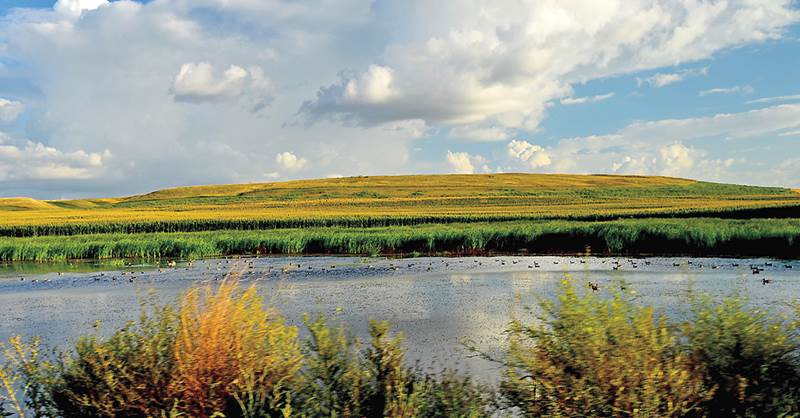 Following several years of drought, wetland conditions on eastern portions of the prairies improved this spring.
Following several years of drought, wetland conditions on eastern portions of the prairies improved this spring.
Photo © Rick Bohn
The estimate for total ducks in the traditional survey area, which spans from Alaska to western Ontario and south into the Dakotas and Montana, was 34.2 million birds, a 12 percent decline from the 2019 estimate and a 4 percent decline from the long-term average. The results from the eastern survey area, which covers central Ontario eastward to Newfoundland and south to Maine, were more encouraging. Populations of nine of the most abundant duck species in that area totaled 4.5 million birds, representing a 10 percent increase from 2019 and a level similar to the long-term average.
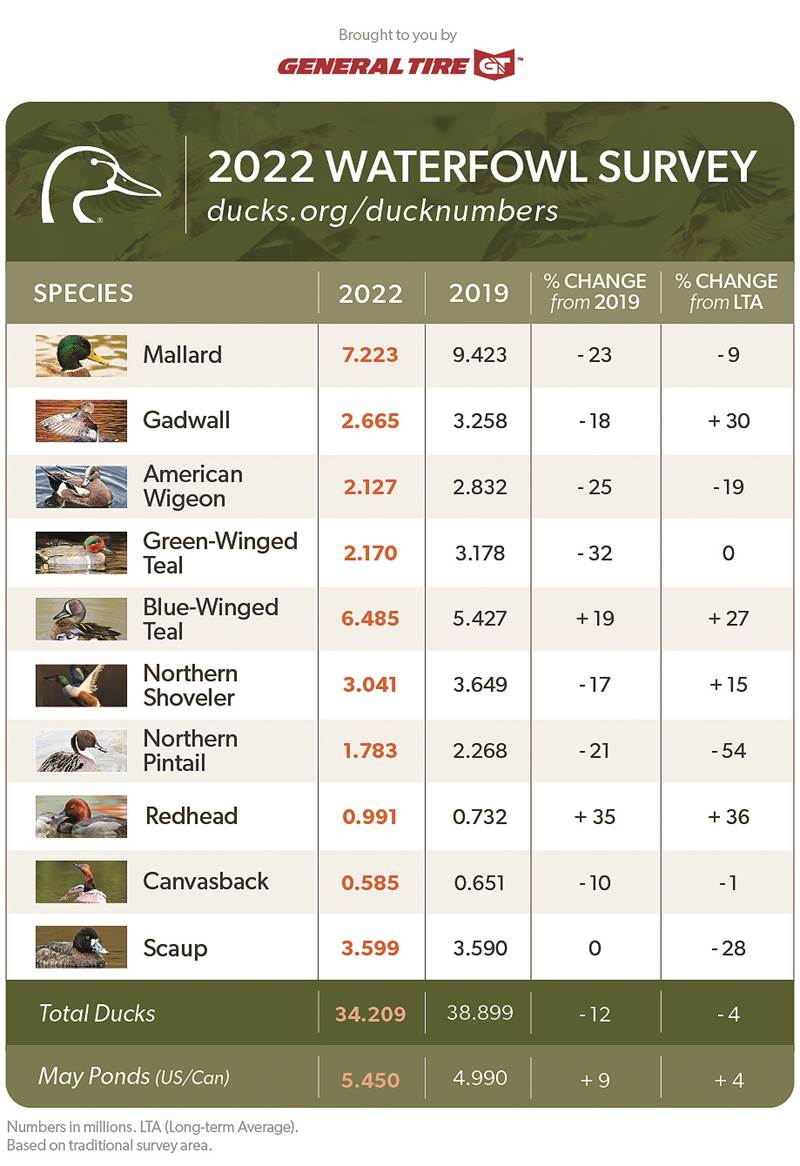 "The drop in duck numbers for the traditional survey area reflects the consequences of low production caused by several years of prairie drought, including severe drought in 2021," notes DU Chief Scientist Dr. Steve Adair. "But the survey revealed some bright spots for duck populations and created optimism for good production this summer and carry over of more favorable wetland conditions into fall and winter."
"The drop in duck numbers for the traditional survey area reflects the consequences of low production caused by several years of prairie drought, including severe drought in 2021," notes DU Chief Scientist Dr. Steve Adair. "But the survey revealed some bright spots for duck populations and created optimism for good production this summer and carry over of more favorable wetland conditions into fall and winter."
The survey also provided a highly anticipated update on the status of individual species, and the results were decidedly mixed. In the traditional survey area, blue-winged teal and redheads were up compared to 2019 estimates, and numbers of both species remained above their long-term averages. Populations of gadwalls, American green-winged teal, and northern shovelers were down substantially from 2019 but remained near or above their long-term averages, indicating that populations of these species remain healthy. Mallards declined by 23 percent and were 9 percent below their long-term average. American wigeon declined by 25 percent and were 19 percent below their long-term average.
The most alarming result concerned northern pintail numbers, which fell to the lowest level in the 67-year history of the survey. Pintails were down 21 percent compared to the 2019 estimate and 54 percent below the long-term average. Rounding out the 10 most abundant species, scaup numbers were almost unchanged but remained 28 percent below the long-term average. The estimate for canvasbacks was comparable to that of 2019 and the long-term average.
When juxtaposed against a record breeding population of 49.5 million total ducks in the traditional survey area seven years ago, this year's estimate of 34.2 million birds might seem a bit concerning, as it represents a decline of 31 percent (15 million ducks) from that record high. However, the decline was not unexpected, and a deeper dive shows that we've been here before. Although the traditional survey area encompasses habitats in the Boreal Forest, Alaska, and the Arctic coastal plain, major swings in duck populations are typically driven by cyclical drought on the prairies. As recently as the early 2000s, we've witnessed declines of 30 percent or more in total duck numbers, only for populations to rebound sharply when wetland conditions on the prairies improved. Hopefully, North America's pothole country is on the verge of recovering from this most recent period of drought.
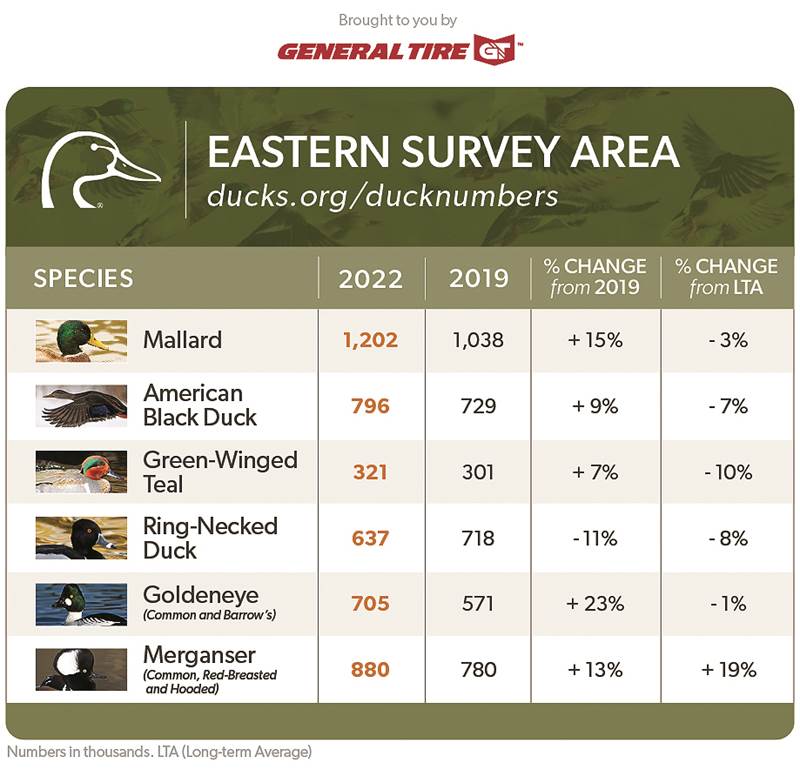 In addition to counting ducks, pilot-biologists and observers also record the number of wetlands (i.e., ponds) on transects across the prairies and parklands. Pond estimates serve as an index for habitat conditions, which play a central role in annual duck production. Despite not having a complete survey in 2020 or 2021, there is no debate that drought plagued key portions of the prairie landscape in both years. Drought was especially severe in 2021 as conditions in some parts of Prairie Canada were the driest in nearly 40 years. Moreover, the water index measured during the North Dakota Game and Fish Department's breeding duck survey was down a record 80 percent from 2020 and 67 percent below its 72-year average. By all accounts, the number of ducks produced on the prairies in 2021 was well below average, and as recently as January 2022, the prospects for recovery were grim.
In addition to counting ducks, pilot-biologists and observers also record the number of wetlands (i.e., ponds) on transects across the prairies and parklands. Pond estimates serve as an index for habitat conditions, which play a central role in annual duck production. Despite not having a complete survey in 2020 or 2021, there is no debate that drought plagued key portions of the prairie landscape in both years. Drought was especially severe in 2021 as conditions in some parts of Prairie Canada were the driest in nearly 40 years. Moreover, the water index measured during the North Dakota Game and Fish Department's breeding duck survey was down a record 80 percent from 2020 and 67 percent below its 72-year average. By all accounts, the number of ducks produced on the prairies in 2021 was well below average, and as recently as January 2022, the prospects for recovery were grim.
The outlook changed, however, when a series of late-winter snowstorms and spring blizzards brought relief to parched landscapes across the Dakotas, southern Manitoba, and southeastern Saskatchewan. In fact, Bismarck, North Dakota, had the snowiest April since 1886, and winter snowfall in Winnipeg, Manitoba, was the third-highest on record. These improvements translated into an abundance of recharged wetlands, and this spring the USFWS estimated 5.45 million ponds across the US and Canadian prairies, which was 4 percent above the long-term average. While the pond estimate was up only 9 percent from 2019, there is little doubt that it was a significant improvement over 2021 conditions. In fact, North Dakota's state duck survey reported a 616 percent increase in the water index, the largest single-year change ever recorded for that survey.
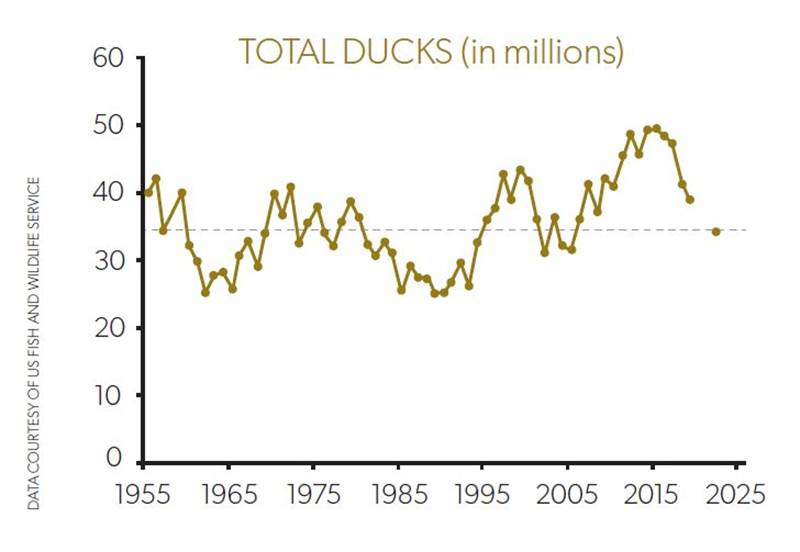 Chart: USFWS
Chart: USFWS
In contrast to whipsawing water conditions on the prairies, wetlands in other survey regions are far more stable over time, and this appears to have been the case again in 2022. Much of the Boreal Forest and Alaska received above-average snowfall and precipitation, with widespread reports of fair to excellent breeding habitat conditions across these regions. However, below-average spring temperatures delayed nesting efforts on many northern breeding areas, resulting in a shorter nesting season and later-hatched broods.
While large-scale summaries of survey results are useful when assessing the overall status of waterfowl populations, understanding the implications for hunters and harvest regulations requires a more in-depth review.
Following is a breakdown of the survey results on a flyway level.
Past studies have revealed that ducks harvested in the Pacific Flyway are derived primarily from breeding grounds in Alaska, British Columbia, Alberta, and locally important areas of Washington, Oregon, and California. In 2022, the total breeding duck estimate across these regions was 15.8 million birds, down 17 percent from 2019 and 7 percent below the long-term average. Not surprisingly, the most notable declines occurred in Alberta and California, both of which remained in severe or exceptional drought. In recent decades, Alaska has become an increasingly important source of ducks for Pacific Flyway hunters, and the state didn't disappoint again in 2022. The total duck estimate in Alaska was up 17 percent from 2019 and comparable to the long-term average.
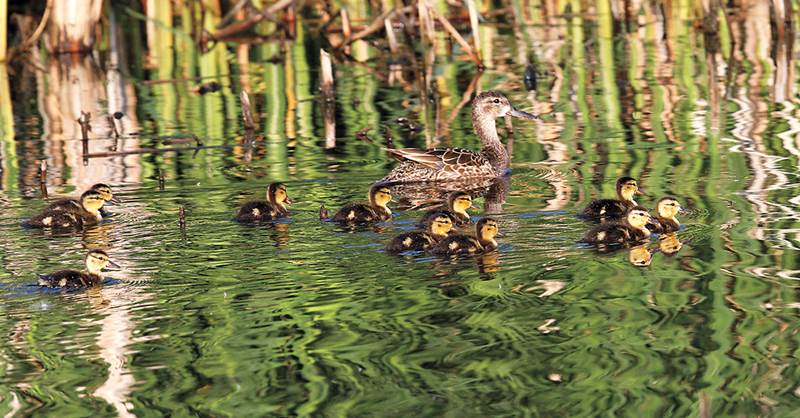 Increased production of blue-winged teal and other waterfowl species likely resulted in more young birds in this year's fall flight.
Increased production of blue-winged teal and other waterfowl species likely resulted in more young birds in this year's fall flight.
Photo © MichaelFurtman.com
The success of most western hunters is disproportionately affected by the status of five species—mallards, northern pintails, northern shovelers, American wigeon, and American green-winged teal—which account for 82 percent of the Pacific Flyway's total duck harvest. While breeding population estimates for these species declined on many western survey areas, most remained near or slightly above their long-term averages. A notable exception was the estimate for northern pintails in these areas, which was actually up 5 percent relative to 2019 but remained 16 percent below the long-term average.
Survey pilots reported that wetlands across the Boreal Forest of northern Alberta and the Northwest Territories, as well as on the coastal plains and river deltas of Alaska, were in good to excellent condition, although nesting habitats in some important areas, such as the Peace-Athabasca Delta, were impacted by excessive precipitation and flooding. Overall, observers expected average to good waterfowl production in these areas.
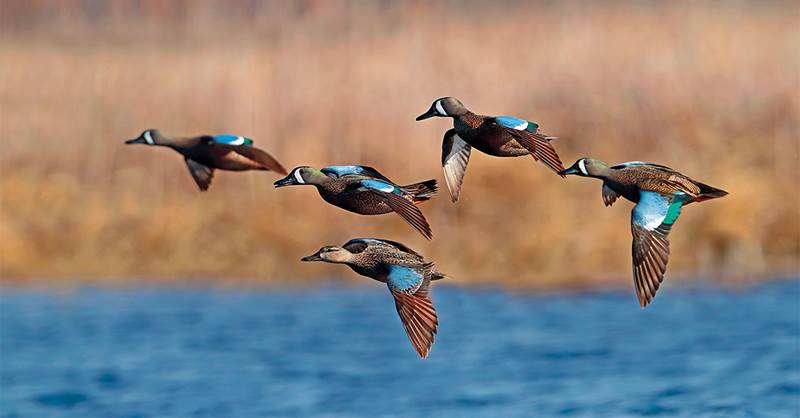 Populations of northern shovelers and blue-winged teal remained above their long-term averages.
Populations of northern shovelers and blue-winged teal remained above their long-term averages.
Photo © GaryKramer.net
The most striking report regarding habitat conditions in the Pacific Flyway came from California and the Intermountain West. This region is in the third consecutive year of drought, and habitat conditions across much of the West have continued to deteriorate. As noted by Dr. Mark Petrie, DU's director of conservation planning in the Western Region, "Many areas in the Pacific Flyway are experiencing the worst drought since 800 A.D., and although duck production in Washington and Oregon should be about average, the same isn't true for California. The mallard estimate there was 46 percent below average, and with severe curtailment of water supplies for rice and managed wetlands this summer, we expect little local production from California." That is a significant loss for the state's waterfowlers, because approximately 60 percent of California's mallard harvest is derived from locally produced birds.
Despite the challenges posed by drought, many Pacific Flyway goose populations remain on an upward trajectory. From cacklers and resident Canada geese to greater whitefronts and light geese (lesser snow and Ross's geese), recent trends indicate continued growth for most goose populations (although the season for dusky Canada geese remains closed), which should provide ample hunting opportunities for waterfowlers out West.
With a few exceptions, most of the waterfowl in the Central and Mississippi Flyways are derived from midcontinent breeding areas, especially the Prairie Pothole Region, Western Boreal Forest, and Great Lakes. In 2022, approximately 60 percent of the ducks in the traditional survey area settled on the US and Canadian prairies, with the highest densities of breeding ducks observed in areas with improved wetland conditions, such as the eastern Dakotas and southern Manitoba. Elsewhere across the prairies and Boreal Forest, duck numbers were generally below average, likely due to drought-related decreases in duck populations in recent years and locally poor habitat conditions. Nevertheless, waterfowl managers are optimistic that ducks had above-average production this year in areas with an abundance of recharged wetlands, which should result in more young birds headed south this fall.
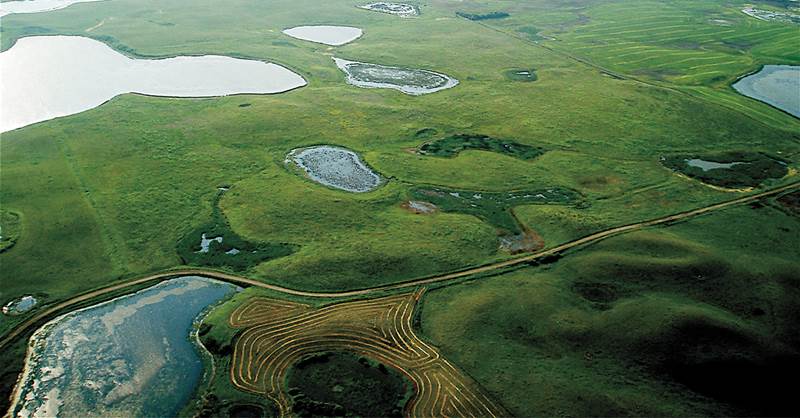
Photo © Ducks Unlimited
Blue-winged teal offered the clearest example of a species going where the habitat was best. Nearly half of the breeding population settled in the eastern Dakotas, and bluewing numbers in southern Manitoba were 123 percent above the previous estimate. The combined total of the four most abundant prairie-nesting dabblers (mallards, blue-winged teal, northern shovelers, and gadwalls) decreased only 11 percent from 2019 and remained 9 percent above the long-term average. Redhead and canvasback populations also demonstrated resilience in the face of drought. Redhead numbers were up 35 percent relative to the 2019 estimate and the long-term average, and along with canvasbacks, returned in strong numbers to areas with improved wetland conditions.
In addition to birds raised on the prairies and in the Boreal Forest, hunters in the upper half of the Mississippi Flyway rely heavily on waterfowl produced in the Great Lake states of Minnesota, Wisconsin, and Michigan. In fact, mallards raised in these three states account for a significant portion of the annual harvest in the region. For a decade or more, Great Lakes mallards were a perennial good news story as this population steadily increased and local hunters reaped the rewards. Since the early 2000s, however, this population has been declining, and in continuation of this trend, the 2022 estimate for Great Lakes mallards was down 17 percent from 2019 and 34 percent below the long-term average.
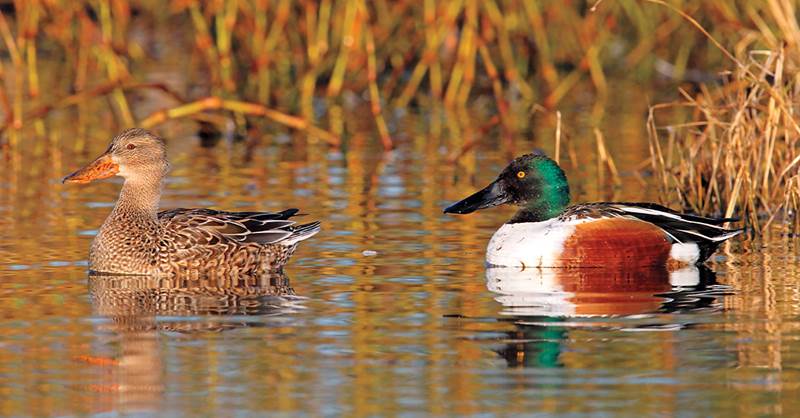
Populations of northern shovelers and blue-winged teal remained above their long-term averages.
Photo © GaryKramer.net
"DU continues to work with our partners to unravel the causes of these declines and identify solutions to help their recovery," says Dr. John Coluccy, DU's director of conservation planning in the Great Lakes/Atlantic Region. "Fortunately, breeding habitat conditions across the Midwest were in good shape in 2022, so hopefully that resulted in favorable production of locally produced mallards and other ducks."
Central and Mississippi Flyway goose hunters should expect continued healthy populations of migratory and resident Canada geese this fall, although production of young birds likely varied based on local weather and habitat conditions. Greater white-fronted geese remain near recent highs, and hunters can look forward to another strong migration of these birds. In contrast, the midcontinent light goose population has declined following several consecutive years of poor production on their northern breeding grounds. This spring, the extent of snow cover and timing of ice-out across the central and western Arctic likely resulted in variable light goose production.
While hunters in the Atlantic Flyway receive some waterfowl from the prairies and Western Boreal Forest, the bulk of the region's birds are raised in the Great Lakes states, the eastern survey area, and local breeding habitats. Due to more stable wetland conditions in the East, populations of most duck species changed only slightly this spring relative to recent estimates and their respective long-term averages. A notable exception was the eastern mallard population, which totaled 1.2 million birds—a 16 percent increase from 2019. Whether this uptick will continue remains to be seen, but it's nevertheless a welcome change given this population's prevailing 30-year decline. In other encouraging news, American black ducks were up 10 percent this spring, creating more optimism that this population has stabilized in recent years near the long-term average.
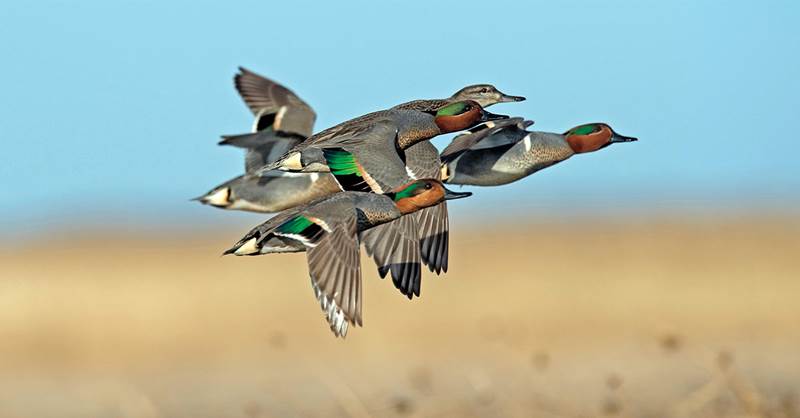
In good news for Atlantic Flyway waterfowlers, American green-winged teal and black ducks were more abundant in the eastern survey area.
Photo © Fred Greenslade
Other species of importance in the flyway include American green-winged teal, ring-necked ducks, wood ducks, and goldeneyes. These species influence not only the numbers of birds that appear over hunters' decoys, but also Atlantic Flyway harvest regulations. Estimates for most of these species were up slightly from 2019 but in general remained near their long-term averages. Due to the difficulty of surveying wood ducks in forested habitats using traditional methods, estimates of this species are derived from other long-term datasets. The 2022 estimate for wood ducks in the Atlantic Flyway was approximately 1 million birds, which was relatively unchanged from previous estimates and the long-term average.
Habitat conditions across much of eastern Canada were good to excellent this spring, with many areas receiving above-average precipitation and winter snowfall. Following a couple of dry years, conditions were much improved in Maine and Atlantic Canada, which are key breeding areas for black ducks. Breeding habitats in the northeastern United States, including states from Virginia to New Hampshire, where additional surveys are conducted to monitor the eastern mallard population, were also described as good. In general, duck production across much of eastern North America was expected to be average or good.
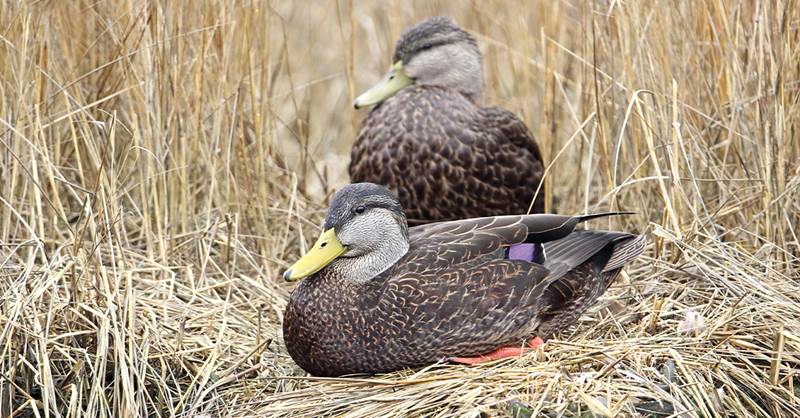 In good news for Atlantic Flyway waterfowlers, American green-winged teal and black ducks were more abundant in the eastern survey area.
In good news for Atlantic Flyway waterfowlers, American green-winged teal and black ducks were more abundant in the eastern survey area.
Photo © GaryKramer.net
As in other flyways, migratory and resident Canada geese should again provide ample hunting opportunities for Atlantic Flyway waterfowlers, although production likely varied according to local weather and habitat conditions. The same is true for greater snow geese, which breed in the eastern Canadian Arctic, where a delayed spring thaw may have impacted breeding success.
The return of the Waterfowl Breeding Population and Habitat Survey in 2022 was welcomed by all who care about North America's waterfowl. "We are grateful for our federal, state, and provincial partners resuming the surveys to gather the data we've all come to rely on," says DU CEO Adam Putnam. "This year's survey revealed what many expected—lower breeding duck populations partly as a result of the drought we've experienced the last few years. While we never like to see these declines, we know that prairie drought can increase wetland productivity and set the stage for better waterfowl breeding success when the water returns, much as it did this spring on some prairie landscapes."
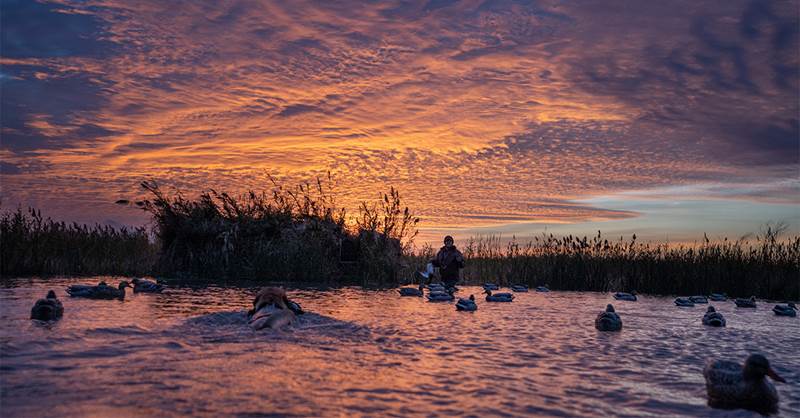 For more information on the survey results, listen to the DU Podcast: https://www.ducks.org/media/du-podcast
For more information on the survey results, listen to the DU Podcast: https://www.ducks.org/media/du-podcast
Photo © Phil Khanke, banded.com
Recent drought on the prairies and continuing drought in the western United States serve as poignant reminders of the importance of Ducks Unlimited's conservation work. Whether protecting and restoring prairie grasslands and potholes, securing vast expanses of the Boreal Forest, or enhancing wetlands on migration and wintering areas, these efforts ensure that vital landscapes remain productive and resilient for waterfowl while also providing places for waterfowlers to pursue our passion. It's another fall and another great opportunity for enjoying the resource. We at DU look forward to joining you in the field.
Dr. Mike Brasher is DU's senior waterfowl scientist based at its national headquarters in Memphis, Tennessee.
Ducks Unlimited uses cookies to enhance your browsing experience, optimize site functionality, analyze traffic, and deliver personalized advertising through third parties. By continuing to use this site, you agree to our use of cookies. View Privacy Policy